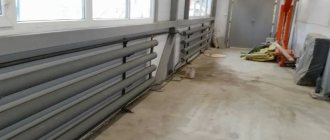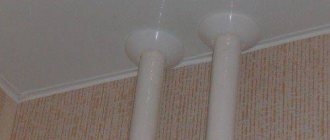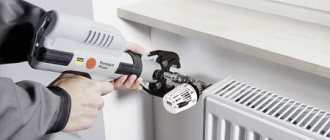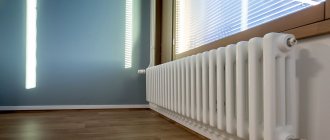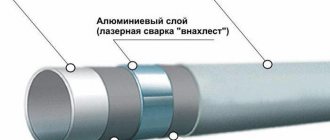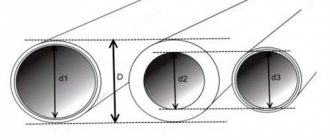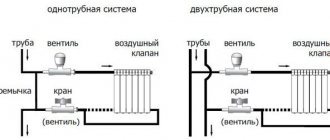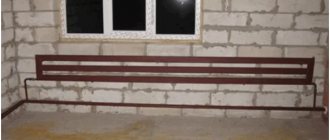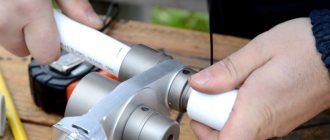It would seem that steel pipes have lost in the competition and are leaving the sphere of private construction forever, being replaced by various types of polymers. But it turned out that the last word had not yet been said and just a few years ago a new product appeared on the market - corrugated stainless pipes for heating and water supply.
Since they are confidently gaining popularity and are of considerable interest to homeowners, they deserve special attention and separate consideration, which will be done in our material.
Specifications
The product is a pipe with corrugated walls, made of AISI 304 stainless steel (according to the domestic classification - 08Х18Н10). The manufacturing technology is as follows: a steel strip of the required width goes through a molding operation, and the output is a corrugated blank in the form of a cylinder with a joint along the entire axis.
The joint is welded in a gas environment in the absence of oxygen so that a sealed, reliable seam is obtained, practically invisible from the outside. For the production of corrugated stainless steel pipes with a diameter of 8 to 32 mm, steel with a thickness of 0.3 mm is used, and for standard sizes of 40 and 50 mm, steel with a thickness of 0.5 mm is used. The corrugation pitch is different for each diameter; for the most popular sizes it is:
- Ø15 mm – 4.76 mm;
- Ø20 mm – 5 mm;
- Ø25 mm – 5.26 mm;
- Ø32 mm – 5.6 mm.
Note. Here and below we provide data from one of the most famous manufacturers of stainless steel pipes - the South Korean brand KOFULSO.
The manufacturer declares normal operation of the product in the temperature range from -50 to +110 ºС with a maximum permissible 150 ºС. Most likely, this limitation is related to the strength of the weld, since the pipe material is subject to changes only at temperatures above 700 ºС. The same applies to the operating pressure, which is 15 Bar in the operating temperature range (for diameters 40 and 50 mm - 8 Bar). The critical fracture pressure is 210 Bar.
Well, the last parameter that interests us is the roughness coefficient of the internal walls. Corrugated stainless steel rolled into a pipe has a very low coefficient - only 0.008. While ordinary new steel has a roughness coefficient from 0.02 to 0.1, during operation this value increases to 0.4 due to corrosion.
Alternatives
In addition to stainless steel, plastic or cast iron (products with a ribbed surface) are used to make corrugated pipes. Plastic products are not the best option for heating, where the operating temperature of the coolant can reach +110ºС, since they can function normally only at temperatures up to +85ºС and a pressure in the system of no more than 20 atmospheres.
Cast iron finned pipes are characterized by high resistance to thermal loads, but they are gradually falling out of mass use due to their high weight, low impact resistance and complex installation process.
Positive and negative sides
The reason for the attractiveness of stainless corrugated pipelines is their many advantages:
- the pipe material is not subject to corrosion;
- judging by the technical characteristics, the product can easily withstand changes in temperature and pressure, water hammer and does not collapse when the coolant freezes;
- the pipe easily bends by hand without disturbing the patency, so some of the traditionally used fittings (bends) are no longer needed;
- installation couldn't be easier. No other type of material is assembled as simply and quickly as corrugation for heating pipes;
- smooth inner surface: due to this, the frictional resistance of the fluid flow is reduced to a minimum, the flow area will not “overgrow”;
- according to the manufacturer, the service life of the corrugated pipe when operated within the operating characteristics is unlimited;
- the weight is almost the same as that of some polymer pipes.
Note. This is not to say that flexible corrugated stainless steel pipes last forever. The service life of a heating or water supply system depends on the quality and reliability of the connections - fittings. However, if problems arise, these elements can be easily replaced with new ones.
Physical properties of CASCATA structures
In addition to the technical characteristics, it is also necessary to consider the physical and chemical qualities of this device. The properties of corrugated structures are considered using the example of a South Korean manufacturer.
Relative minimum water flows:
| DN | Consumption in l/hour |
| 12,0 | 12,000 |
| 15 | 1550 |
| 20 | 2000 |
| 30 | 4550 |
Reduction coefficients for optimal pressure depending on temperature indicators (the data below is given at t = +55 degrees Celsius):
| Temperature | Relative coefficient of optimal pressure |
| 30 | 1,55 |
| 55 | 0,90 |
| 130 | 0,85 |
| 145 | 0,75 |
Area of 1 square meter (exact data):
| Relative size | 12.0 A | 15 A | 20 A | 30 A |
| m² | 0,064652 | 0,095505 | 0,121384 | 0,15118 |
Read more about the disadvantages
Like any normal material, stainless corrugation has a number of disadvantages, the most significant of which is its high price. Because of this, it cannot be called accessible to a wide range of users. In current times, when the incomes of citizens of post-Soviet countries leave much to be desired, this is a big minus. Although everyone understands that you should pay the appropriate money for reliability and durability.
The second drawback is its unpresentable appearance. Not everyone will like the heating system shown in the photo above, and it may not fit harmoniously into every interior. But it is worth noting that recently corrugated heating pipes with polymer coatings of different colors have appeared. This improved the situation somewhat, but there is a nuance here: the recesses in the pipe eventually fill with dust, which is not so easy to remove.
The conclusion suggests itself that our corrugations have no equal when using a closed installation method, but this is not entirely true. Due to detachable connections using polymer seals, it is not recommended to embed the entire system into the floor or walls; only a pipe can be used, without fittings. This causes some inconvenience when installing radiator heating, but it is hardly possible to find the best material for installing heated floors.
There is one more point. Despite the ideal smoothness of the inner surface, the corrugated stainless steel pipe has many stiffeners that provide additional resistance to fluid flow. Any specialist knowledgeable in hydraulics will say that these ribs should be considered as a set of local resistances located at a certain pitch.
As a result, the structure of the water flow is far from ideal (laminar); rather, the flow is turbulent throughout the entire length of the pipe. This means that, theoretically, a corrugated pipe has a higher hydraulic resistance than any polymer pipe, where the surface is just as smooth, but without ribs.
Since there are no supporting theoretical calculations, let’s turn to practice. According to homeowners' reviews, the stainless corrugated heating pipe did not require the installation of a high-pressure circulation pump, although the system was designed to use polymer pipes. It can be concluded that corrugation is unsuitable for gravitational systems with natural coolant circulation, but there is no practical confirmation of this. Accordingly, we will not make recommendations based on unverified data.
And one last thing. As a thin-walled metal product, stainless corrugation can suffer over time from Foucault eddy currents where it intersects with the home's electrical networks. It is better not to take risks and prevent electrochemical corrosion by taking appropriate measures during installation, as discussed below.
Manufacturers and what to look for when purchasing
There are currently the most Korean companies in our market:
- KOFULSO (“Kofulso”) - according to experts, the best quality, since it was the first to appear on the market and has quite a lot of production experience. It has twice the thickness of the seal rings in the fittings, and the weight of the fittings and coils of pipes of the same name is greater. So the increased cost (compared to Hydrosta and Lavita) is justified.
- Lavita (“Lavita”) - performs quite well, but there may be problems in the fittings - sometimes when tightening, the metal ring cuts through the wall (may be due to an installation error - tightening the clamping ring), which causes leaks (per 100 fittings 1-2) - costs less than Cofulso.
- Hydrosta (“Hydrosta” or “Hidrosta”) is in the same price category as Lavita, but there are complaints about leaking fittings: for every 100 installed, 5-7 pieces leak.
- Neptune (“Neptune”) – characteristics and reviews could not be found;
- Meibes (Meibas) - there are no complaints about the quality, but there are some for the price - very expensive with approximately equal parameters to those given above in the list.
The reliability data was taken from the installer’s post on the forum, this is the result of several years of use: first we worked with Cofulso, then switched to the cheaper Lavita and Hirostat, after replacing fittings and, accordingly, customer complaints, we weighed, looked, and returned to KOFULSO.
Recommendations for selection
The first confusion that awaits you when choosing is that the stainless heating pipe is not marked. All information about the manufacturer and technical parameters of the product is printed on the packaging of the coil. That is, with a certain dexterity, it costs nothing for an unscrupulous seller to pack a not very high-quality product from the Middle Kingdom into the packaging of the famous South Korean brand KOFULSO or LAVITA. There are two options here: trust the sales representative or purchase the material from places recommended by friends who have already purchased and installed the system some time ago.
As for the recommended brands, at the moment the most popular are the mentioned “Koreans” KOFULSO and LAVITA, which have been tested in operation and have proven themselves to be good. Moreover, LAVITA products are somewhat cheaper, but the quality is slightly worse. There are also a number of German brands, but their stainless steel corrugation is unreasonably expensive. Well, you shouldn’t pay attention to unknown companies whose products are surprisingly cheap. Surely such pipes do not have the required wall thickness.
How are corrugated pipes made from stainless steel?
The technical conditions for the manufacture of corrugated pipes regulate the use of AISI 304 stainless steel.
It is produced using the following technology:
- the stainless steel sheet enters the forming machine, where it takes on a cylindrical shape;
- the edges of the cylinder are welded together by laser, plasma or induction current;
- the strength of the weld is checked by eddy currents;
- then the workpiece undergoes calibration, during which the product acquires a characteristic wavy structure;
- When leaving the calibrating machine, cutting to the required length is carried out.
Such a pipe can already be used for installation, but it is less durable and ductile. To increase these indicators, products are subjected to heat treatment (firing) at a temperature of +600ºС, followed by a period of forced cooling (tempering).
Visually, the products are no different, but after firing they become stronger and more flexible, which means that when bent, creases will not form on them, as on unmolded corrugation.
Installation recommendations
As mentioned above, assembling stainless corrugated systems is extremely simple. Judge for yourself: the only special tools required are a knife that allows you to quickly cut the pipe strictly at an angle of 90º. In addition, you will need open-end wrenches to tighten the nuts and that’s all. There is no need to do any stripping or chamfering; the cut pipe is simply inserted into the fitting and clamped with a wrench. Only first you need to disassemble the tee, remove all the rings and, following the nut, put it on the pipe in the same order.
The pipe must be carefully bent manually in place to the required angle, observing the smallest bending radii. They are easy to calculate: the bending radius is equal to the diameter of the pipe, multiplied by 3. Despite the fact that the product has good rigidity and low weight, the installation of stainless pipes must be done in such a way as to prevent the slightest sagging. The supports should be placed in areas of high load, for example, where fittings and connections to radiators are located. Linear elongation does not need to be taken into account; it is insignificant.
Advice. In places where it intersects with electrical networks, it is recommended to put a case made of a steel pipe on a corrugated pipe that is laid hidden. It will serve as a screen for eddy currents and protect the material from electrochemical corrosion.
As for heated floors, their installation is carried out using traditional technology. Two additional requirements must be met:
- the pipe must be in a polymer sheath;
- Joints with fittings cannot be embedded in the screed.
Features of installing a warm water floor made of corrugated steel pipe
Due to the very high coefficient of thermal conductivity, corrugated stainless steel pipe can be laid with a large pitch between turns. The concrete is qualitatively heated to a distance of up to 10 cm on each side of the corrugation. This means that the optimal distance between the loops is 20 cm, but even when the pipes are located at a distance of up to 35 cm, effective floor heating can be achieved. This result is obtained due to the peculiarities of heat distribution by the corrugated surface.
Laid steel corrugation
Important! It is recommended to install a warm water floor from a corrugated pipe according to the principle of one coil per circuit (minimum connections).
Approximate diagram of a warm water floor The main advantage of stainless steel corrugation is its elasticity; it can be easily bent to any desired shape without the use of special tools. This means that it is possible to install a heated floor from a corrugated steel pipe yourself. The clearance of the corrugation at the bend does not change.
Important! It is recommended to lay corrugated steel pipe over the entire area of the room with the same spacing.
Features of corrugated stainless steel unannealed pipe
We will continue the topic of what are the differences between stainless steel corrugated annealed and unannealed pipes by considering the second type of these products. Structurally, unannealed pipes differ only in the shell material. Steel that has not undergone heat treatment is more rigid. Pipes of this type require a larger bending radius, which creates inconvenience when working with them in cramped conditions. They cannot be used for rolling joints because the unannealed corrugated casing has insufficient ductility.
If you make a mistake when bending unannealed pipes, then after alignment, visible traces of previous bends will remain on the corrugation. Therefore, such work requires special care.
As for marking, unannealed pipes are indicated by the following symbols:
- GF at Lavita;
- A at Kofulso;
- TN at Hydrosta.
Let us remind you that there are no external differences between the two types of pipes, but they exist for products designed for different installation conditions and main intended purposes. We must also remember that, other things being equal, the cost of a meter of unannealed corrugated pipes is approximately 10% lower than that of annealed products.
Connection methods
To connect stainless steel corrugated pipes, a brass compression fitting with a silicone or rubber O-ring is used. The end of the pipe is inserted into it until it stops and tightened with a ring.
When switching from a smooth steel pipe to a corrugated one, the fitting is first attached to the smooth pipe, and then a stainless corrugated pipe is inserted into it.
Flexible radiator connection
A manual rolling machine is used to make flexible hoses for radiators and heaters.
First, a piece of pipe of the required length is cut with a pipe cutter or grinder, and the cut line is carefully cleaned. The pipe is then inserted into the protruding flaring machine onto two corrugated rings to allow the protruding edge to be flared using a hammer. Next, a union nut with a rubber gasket is put on this end of the pipe. Attaching the union nut to the other end is done in the same way.
Advantages of using stainless steel corrugation in heating systems
Corrugated stainless steel pipes have features that set them apart from other types of heating pipes:
- They bend in all directions (a large bending radius even helps to build a radiator or heated towel rail from corrugated material). This property of the product allows it to be used in rooms of different configurations, eliminating the need to purchase rotating corners as in products made of plastic and metal.
- They are not afraid of negative temperatures (if your heating system is frozen, the integrity of the pipe will not be compromised, and you can thaw it using any available methods).
- They have high strength (withstand pressure over 200 atmospheres).
- Do not react to atmospheric influences (do not rust).
- They have good heat dissipation.
- Suitable for laying heated floors and laying in the wall.
- Withstands temperatures up to 150 degrees.
- Not exposed to fungus.
- They have a low roughness coefficient, which maintains high throughput without the use of additional equipment.
- They are not afraid of rodents.
- Easy to install, require a minimum of connecting elements, cut with a pipe cutter.
- Convenient to transport.
- Can be dismantled without difficulty.
Subject to operating rules, manufacturers set a minimum service life of 20 years.
Which corrugation is better?
Lavita is a manufacturer of corrugated stainless steel pipes for heating in the mid-market price segment. However, this product has complaints from consumers regarding the strength characteristics of the walls: when installing fittings, there is a danger of damaging the stainless steel, which subsequently causes leaks. However, this drawback is most likely the result of illiterate installation.
Hydrosta's products are comparable in price to pipes from Lavita, but often have factory defects. Leaks at fitting installation sites occur on average in 7% of systems assembled from these pipes.
The products of the Meibes company are quite high quality, but their cost is considered unreasonably high.
Corrugated stainless steel pipes for heating Kofulso are considered the best among similar products. It’s true that their price is several times higher than the cost of corrugations from the previous manufacturer. These models are connected with fittings equipped with thicker O-rings, which provides a more reliable connection.
